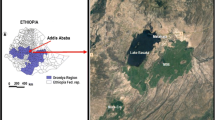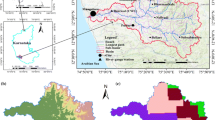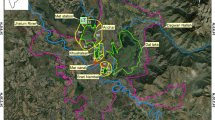Abstract
Determining how land clearing and other land use changes will affect the amount of runoff is among the most important issues related to the watershed management. In this study, the L-THIA GIS model was applied to calculate the height and volume of runoff as well as the contribution of each land use type to producing runoff in a watershed under intense development pressure in the north of Iran. Different land use scenarios were also simulated using the CLUE-s model based on varying demands of each of the land use types. In this study, three different periods of 1986, 2000, and 2011 for the base period and 5 land use change scenarios for year 2030 were prepared. The results showed that the CLUE-s model is a suitable model to simulate future land use changes through the use of a ROC curve. The simulated runoff heights and runoff volumes were 132.55–165.31 mm and 119.295–148.779 m3/cell in base and future periods, respectively. The simulation of runoff under different land use scenarios showed that the amount of runoff in all the scenarios is more than the base period so that in a 44-year period (1986–2030) (assuming that the current rate of demand for land is constant), the total volume of runoff will increase by 54 % due to land use changes. The amount of runoff is also affected by the amount of land use demand, so that the amount of runoff reduces with the decrease in demand. The increased runoff, rise in urbanization as well as indiscriminate cutting of forests are the most important factors that contribute to increased runoff in the study area, and the development of new residential areas causes the most significant increases in runoff. This study has shown that the hydrologic effects of land use changes can be reduced with an exact physical design of area land use through controlling the demand of each land use.
















Similar content being viewed by others
References
Anderson JR (1976) A land use and land cover classification system for use with remote sensor data, vol 964. US Government Printing Office
Arnold JG, Srinivasan R, Muttiah RS, Williams JR (1998) large area hydrologic modeling and assessment part I: model development. J Am Water Res Assoc 34:73–89
Arsanjani J, Helbich M, Kainz W, Boloorani AD (2013) Integration of logistic regression, Markov chain and cellular automata models to simulate urban expansion. Int J Appl Earth Obs Geoinf 21:265–275
Arvidson T (2002) Personal correspondence, landsat 7 senior systems engineer. Landsat Project Science Office, Goddard Space Flight Center, Washington, DC
Bhaduri B, Minner M, Tatalovich S, Harbor J (2001) Long-term hydrologic impact of urbanization: a tale of two models. J Water Resour Plann Manage 127(1):13–19
Bronstert A, Niehoff D, Burger G (2002) Effects of climate and land-use change on storm runoff generation: present knowledge and modeling capabilities. Hydrol Process 16:509–529
Calder IR (2007) Forests and water—ensuring forest benefits outweigh water costs. For Ecol Manag 25:110–120
Chander C, Markham B, Helder D (2009) Summary of current radiometric calibration coefficients for Landsat MSS, TM, ETM+, and EO-1 ALI sensors. Remote Sens Environ 113:893–903
Chen Y, Xu Y, Yin Y (2009) Impacts of land use change scenarios on storm-runoff generation in Xitiaoxi basin, China. Quat Intern 208:121–128
Costa MH, Botta A, Cardille J (2003) Effects of large-scale changes in land cover on the discharge of the Tocantins River, Southeastern Amazonia. J Hydrol 283:206–217
Coutu G, Vega C (2007) Impacts of land use changes on runoff generation in the east branch of the Brandywin Creek watershed using a GIS-based hydrologic model. Middle States Geogr 40:142–149
Dan W, Wei H, Shuwen Z, Kun B, Bao X, Yi W, Yue L (2015) Processes and prediction of land use/land cover changes (LUCC) driven by farm construction: the case of Naoli River Basin in Sanjiang Plain. Environ Earth Sci 73:4841–4851
Du J, Rui H, Zuo T, Li Q, Zheng D, Chen A, Xu Y, Xu CY (2013) Hydrological simulation by SWAT model with fixed and varied parameterization approaches under land use change. Water Resour Manag 27:2823–2838
Engel B (2005) Long-term hydrological impact assessment version-2.3. United States Environmental Protection Agency (EPA). http://www.ecn.purdue.edu/runoff
Engle BA, Choi JY, Harbor J, Pandey S (2003) Web-based DSS for hydrologic impact evaluation of small watershed land use changes. Comput Electron Agric 39:241–249
Farley KA, Jobbagy EG, Jackson RB (2005) Effects of afforestation on water yield: a global synthesis with implications for policy. Glob Change Biol 11:1565–1576
Foley JA, DeFries R, Asner GP, Barford C, Bonan G, Carpenter SR, Chapin FS, Coe MT, Daily GC, Gibbs HK, Helkowski JH, Holloway T, Howard EA, Kucharik CJ, Monfreda C, Patz JA, Prentice CI, Ramankutty N, Snyder PK (2005) Global consequences of land use. Science 22:570–574
Fullen MA (1998) Effects of grass ley set-aside on runoff, erosion and organic matter levels in sandy soils in East Shropshire, UK. Soil Tillage Res 46:41–49
Harbor JM (1994) A practical method for estimating the impact of land use change on surface runoff, ground water recharge and wetland hydrology. J Am Plan Assoc 60:91–104
Harbor JM, Grove M, Bhaduri B, Minner M (1998) Long-term hydrologic impact assessment (L-THIA) GIS. Public Works 129:52–54
Hundecha Y, Bardossy A (2004) Modeling of the effect of land use changes on the generation of a river basin through parameter regionalization of a watershed model. J Hydrol 292:281–295
Kok K, Winograd M (2002) Modelling land-use change for Central America, with especial reference to the impact of hurricane Mitch. Ecol Model 149:53–69
Lim KJ, Engel BA, Tang Z, Muthukrishnan S, Chio J, Kim K (2006) Effects of calibration on L-THIA GIS runoff and pollutant estimation. J Environ Manag 78:35–43
Lin B, Chen X, Yao H, Chen Y, Liu M, Gao L (2015) Analyses of landuse change impacts on catchment runoff using different time indicators based on SWAT model. Ecol Indic 58:55–63
Liu YB, De Smedt F, Hoffmann L, Pfister L (2004) Assessing land use impacts on flood processes in complex terrain by using GIS and modeling approach, Luxembourg. Environ Model Assess 9:227–235
Luo G, Yin C, Chen X, Xu W, Lu L (2010) Combining system dynamic model and CLUE-s model to improve land use scenario analyses at regional scale: a case study of Sangong watershed in Xinjiang, China. Ecol Complex 7:198–207
Lyon SW, Laudon H, Seibert J, Mörth M, Tetzlaff D, Bishop K (2010) Controls on snowmelt water mean transit times in northern boreal catchments. Hydrol Process 24(12):1672–1684
Mohammady M, Moradi HR, Zeinivand H, Temme AJAM, Pourghasemi HR, Alizadeh H (2013) Validating gap-filling of Landsat ETM+ satellite images in the Golestan Province, Iran. Arab J Geosci 7(9):3633–3638
Mohammady M, Morady HR, Zeinivand H, Temme AJAM (2014) A comparison of supervised, unsupervised and synthetic land use classification methods in the North of Iran. Int J Environ Sci Technol 12(5):1515–1526
Neary DG, Ice GG, Jackson CR (2009) Linkages between forest soils and water quality and quantity. For Ecol Manag 258:2269–2281
Olivera F, Maidment D (1999) Geographic information systems (GIS)-based spatially distributed model for runoff routing. Water Resour Res 35(4):1155–1164
Ott B, Uhlenbrook S (2004) Quantifying the impact of land use changes at the event and seasonal time scale using a process-oriented catchment model. Hydrol Earth Syst Sci 8:62–78
Pandey S, Gunn R, Lim K, Engel B, Harbor J (2000) Developing a Web-enabled Tool to Assess Long-term Hydrologic impacts of landuse change, information technology issues and a case study. J Urban Reg Inf Syst Assoc 12(4):5–17
Paroissein J, Darboux F, Couturier A, Devillers B, Mouillot F, Raclot D, Bissonnais Y (2015) A method for modeling the effects of climate and land use changes on erosion and sustainability of soil in a Mediterranean watershed (Languedoc, France). J Environ Manag 150:57–68
Perry T, Nawaz R (2008) An investigation into the extent and impacts of hard surfacing of domestic gardens in an area of Leeds, United Kingdom. Landsc Urban Plan 86:1–13
Petchprayoon P, Blanken PD, Ekkawatpanit C, Hussein K (2010) Hydrological impacts of land use/land cover change in a large river basin in central-nortnern Thailand. Int J Clim 30:1917–1930
Purdue Research Foundation (2004) Long-term impact assessments. Perdue University, Indiana. http://www.ecn.purdue.edu/runoff/lthia/basicinputfileupload.htm
Sajikumar N, Remya R (2015) Impact of land cover and land use change on runoff characteristics. J Environ Manag 161:460–468
Sanyal J, Densmore A, Carbonneau P (2014) Analysing the effect of land-use/cover changes at sub-catchment levels on downstream flood peaks: a semi-distributed modelling approach with sparse data. Catena 118:28–40
Shan J, Alkheder S, Wang J (2012) Genetic algorithms for the calibration of cellular automata urban growth modeling. Photogram Eng 74:1267–1277
Sun Z, Guo H, Li X, Huang Q, Zhang D (2011) Effect of LULC change on surface runoff in urbanization area. Proceedings of the ASPRS 2011 Annual Conference, Milwaukee, Wisconsin, May 1–5
Tang Z, Engel BA, Pihanwski BC, Lim KJ (2005) Forecasting land use change and its environmental impact at a watershed scale. J Environ Manag 76:35–45
USDA (United States Department of Agriculture Natural Resources Conservation Service) (1986) Urban hydrology for small watersheds, technical release 55, 2nd edn. NTIS PB87-101580, Springfield, Virginia. ftp://wcc.nrcs.usda.gov/downloads/hydrologyhydraulics/tr55/tr55.pdf
Van der Velde Y, Lyon SW, Destouni G (2013) Data-driven regionalization of river discharges and emergent land cover—evapotranspiration relationships across Sweden. J Geophys Res D: Atmos 118:2576–2587
Pérez-Vega A, Mas JF, Ligmann-Zielinska A (2012) Comparing two approaches to land use/cover change modeling and their implications for the assessment of biodiversity loss in a deciduous tropical forest. Environ Model Softw 29:11–23
Veldkamp A, Fresco LO (1996) CLUE-CR: an integrated multi-scale model to simulate land use change scenarios in Costa Rica. Ecol Model 91:231–248
Verburg PH (2010) The clue modelling framework: course material. Amsterdam University Institute for Environmental Studies, Amsterdam
Verburg PH, Veldkamp A, de Koning GHJ, Kok K, Bouma J (1999) A spatial explicit allocation procedure for modelling the pattern of land use change based upon actual land use. Ecol Model 116:45–61
Verburg PH, Soepboer W, Veldkamp A, Limpiada R, Espaldon V (2002) Modeling the spatial dynamics of regional land use: the CLUE-S model. J Environ Manag 30:391–405
Verburg PH, Overmars KP, Huigen MGA, de Groot WT, Veldkamp A (2006) Analysis of the effects of land use change on protected areas in the Philippines. Appl Geogr 26:153–173
Viilers L, Donnell J (2013) Land use change effects on runoff generation in a humid tropical montane cloud forest region. Hydrol Earth Syst Sci 17:3543–3560
Wang Y, Woonsup C, Brian M (2005) Long-term impacts of land-use change on non-point source pollutant loads for the St. Louis metropolitan area, USA. Environ Manage 35(2):194–205
Weng Q (2001) Modeling urban growth effects on surface runoff with the integration of remote sensing and GIS. Environ Manag 28(6):737–748
Xu L, Li Z, Song H, Yin H (2013) Land-use planning for urban sprawl based on the CLUE-s model: a case study of Guangzhou, China. Entropy 15:3490–3506
Young RA, Onstad CA, Bosch D, Anderson WP (1987) AGNPS, agricultural non-point source pollution model: a watershed analysis tool, USDA; conservation research report 35. U.S. Department of Agriculture, Agricultural Research Service, Washington, DC, pp 49–51
Yuan Z, Chu Y, Sheh Y (2015) Simulation of surface runoff and sediment yield under different land-use in a Taihang Mountains watershed, North China. Soil Tillage Res 153:7–19
Zhang L, Podlasky C, Feger K, Wang Y, Schwarzel K (2015) Different land management measures and climate change impacts on the runoff—A simple empirical method derived in a mesoscale catchment on the Loess Plateau. J Arid Environ 120:42–50
Author information
Authors and Affiliations
Corresponding author
Rights and permissions
About this article
Cite this article
Zare, M., Samani, A.A.N. & Mohammady, M. The impact of land use change on runoff generation in an urbanizing watershed in the north of Iran. Environ Earth Sci 75, 1279 (2016). https://doi.org/10.1007/s12665-016-6058-7
Received:
Accepted:
Published:
DOI: https://doi.org/10.1007/s12665-016-6058-7




